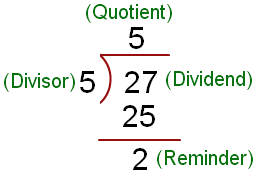In Division The number which we divide is called the dividend. The number by which we divide is called the divisor. The result obtained is called the quotient. The number left over is called the remainder.

Problem Definition
Create a Python program to compute Quotient and reminder of two given numbers.
Program
divisor = 5
dividend = 27
quotient = dividend//divisor
reminder = dividend % divisor
print("Quotient is", quotient)
print("Reminder is",reminder)Output
Quotient is 5
Reminder is 2First, the numbers are saved in respective variables then to compute quotient we used the floor division // operator that returns the integer value of the quotient and for the reminder, the modulus % operator is used. Later we are just printing out the variables.
Problem Definition
Create a Python program to compute Quotient and reminder of two user-provided numbers in real-time.
Program
divisor = int(input("Enter the divisor"))
dividend = int(input("Enter the dividend"))
quotient = dividend//divisor
reminder = dividend % divisor
print("Quotient is {} and Reminder is {}".format(quotient, reminder))Output
Enter the divisor 5
Enter the dividend 27
Quotient is 5 and Reminder is 2Here we are taking input from the user using the Python's built-in input() method then we are converting it to an integer using the int() method because input() returns the objects as a string object.
Later we are performing the arithmetic operation and printing out the results using string formatting.